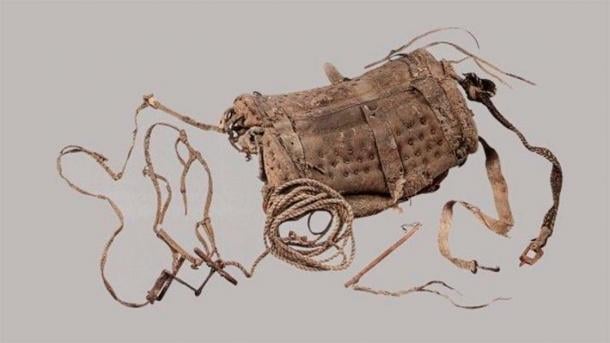2,700-Year-Old Horse Saddle in Chinese Tomb May Be World’s Oldest!

Archaeologists in China have discovered a 2,700-year-old leather horse saddle. Not only is this maybe the oldest saddle ever discovered, but having been found in a woman’s tomb it contradicts historical narratives associating horse riding with male elites.
The leather horse saddle was recovered from a Bronze Age woman’s tomb at a cemetery in Yanghai, in the Tarim Basin of the Xinjiang Uygur Autonomous Region, in northwest China. Discovered in 2003, this site contained well-preserved mummies, artifacts, and textiles which offer valuable insights into the lifestyles of the people who lived in the region over 3,000 years ago.
The leather saddle comprises two cowhide cushions which are filled with a blend of straw mixed with deer and camel hair. A new study, published this week in the journal Archaeological Research in Asia, claims that radiocarbon dating determined the saddle was made between 724 and 396 BC, and states that it “may be the earliest saddle ever found”.
Buried With Her Buttocks in A Saddle
Dating to 724 and 396 BC, the saddle is older than similar saddles discovered in Scythian tombs in Russian Siberia, and in eastern Kazakhstan. And it is known that nomadic Scythian horse riders, from the western and central Eurasian Steppe, were making horse saddles between the 5th and the 3rd centuries BC.
The study says the woman in the tomb was dressed in a hide coat, woollen pants and leather boots, which suggests she had been an equestrian. Furthermore, supporting this idea, lead author of the new study, Patrick Wertmann, an archaeologist at the University of Zurich, told Live Science that the leather saddle was “placed on her buttocks as if she was seated on it.”
The Ancient Origins of Saddle Making
Yanghai, in the Turpan Basin region, was inhabited by Subeixi people, about 3,000 years ago. The Subeixi people of northwest China had a rich cultural heritage revolving around horsemanship and craftsmanship, and the team of archaeologists found a second saddle, from a nearby Subeixi graveyard. Both saddles were made at about the same time, and Wertmann added that they were created “at the beginning of the history of saddle making”.

Yanghai cemetery tomb IIM205 with the position of the leather saddle indicated by the red circle. Source: Turfan Administration of Cultural Relics et al., 2019/Archaeological Research in Asia
Archaeological evidence suggests that in China horses were domesticated as herd animals up to 6,000 years ago, at which time they were used for milk and meat. However, it is unclear when, or where, saddles were first invented, but they are most often associated with nomadic horse-riders in Central Asia, about the mid-first millennium BC.
The Evolution of War Saddles
Assyrian cavalrymen are depicted in 7th century BC carvings using mats secured to the backs of horses with foot straps. Wertmann said the first seat-shaped saddles had no supporting stirrups, but the early Scythian saddles, and the ancient Yanghai saddle, “both have distinct supports.” The addition of stirrups enabled riders to raise themselves on their horses when shooting arrows in battle.
The paper says the ancient Subeixi people “had similar weaponry, horse gear and garments to the Scythians,” but while the latter were nomads, the Subeixi horse-riders were pastoralists who reared herd animals within the Turpan Basin.

The second saddle found in a graveyard nearby. (Wertmann et al, 2023 / Archaeological Research in Asia)
A Woman Horse Rider Challenging Traditional Narratives
The Live Science article speaks with Birgit Bühler, an archaeologist at the University of Vienna, who said the seated position of the buried woman on the saddle “is very revealing,” as it suggests she was a horse rider. Wilkin added that because the saddle was discovered in an ordinary tomb “this really shifts our ideas about who was riding horses.”
Bühler says the discovery serves as solid evidence for women participating in “the day-to-day activities of mounted pastoralists, which included herding and travelling.” If this interpretation is accurate, the findings challenge historical narratives which generally associate horse-riding with warfare by elite men, said Bühler.
This discovery also challenges the oldest current archaeological evidence of a woman riding a horse, which dates back to the Scythian period, around the 5th century BC. In the ancient region of Kazakhstan, the burial site of a Scythian noblewoman known as the “Ice Maiden” contained the remains of a horse, suggesting she was a skilled equestrian and the prominent role of women horse riders in Scythian society.
